Chapter: Java The Complete Reference : The Java Library : Exploring java.lang
Primitive Type Wrappers - Exploring java.lang
Primitive
Type Wrappers
As mentioned in Part I of
this book, Java uses primitive types, such as int and char, for
performance reasons. These data types are not part of the object hierarchy.
They are passed by value to methods and cannot be directly passed by reference.
Also, there is no way for two methods to refer to the same instance of an int.
At times, you will need to create an object representation for one of these
primitive types. For example, there are collection classes discussed in Chapter
18 that deal only with objects; to store a primitive type in one of these
classes, you need to wrap the primitive type in a class. To address this need,
Java provides classes that correspond to each of the primitive types. In
essence, these classes encapsulate, or wrap,
the primitive types within a class. Thus, they are commonly referred to as type wrappers. The type wrappers were introduced in Chapter 12. They are examined
in detail here.
Number
The abstract class Number defines a superclass that is
implemented by the classes that wrap the numeric types byte, short, int, long, float, and double. Number has abstract methods that return the value of the object in
each of the different number formats. For example, doubleValue( ) returns the value as a double, floatValue( ) returns
the value as a float, and so on. These methods are shown here:
byte byteValue( ) double
doubleValue( ) float floatValue( )
int intValue( ) long
longValue( ) short shortValue( )
The values returned by these
methods might be rounded, truncated, or result in a “garbage” value due to the
effects of a narrowing conversion.
Number has concrete subclasses that hold explicit values of each primitive
numeric type: Double, Float, Byte, Short, Integer, and Long.
Double
and Float
Double and Float are wrappers
for floating-point values of type double
and float, respectively. The constructors for Float are shown here:
Float(double num) Float(float num)
Float(String str) throws NumberFormatException
As you can see, Float objects can be constructed with
values of type float or double. They can also be constructed
from the string representation of a floating-point number.
The constructors for Double are shown here:
Double(double num)
Double(String str) throws NumberFormatException
Double objects can be constructed with a double value or a string containing a floating-point value.
The methods defined by Float include those shown in Table
17-1. The methods defined by Double
include those shown in Table 17-2. Both Float
and Double define the following
constants:
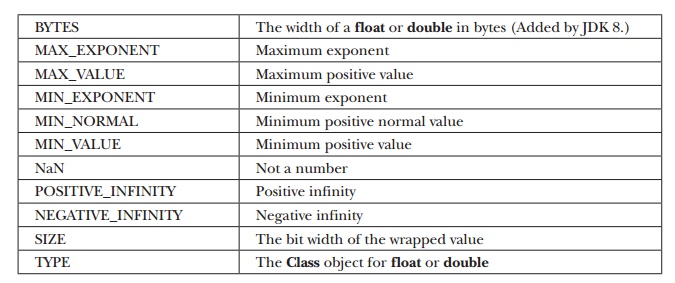
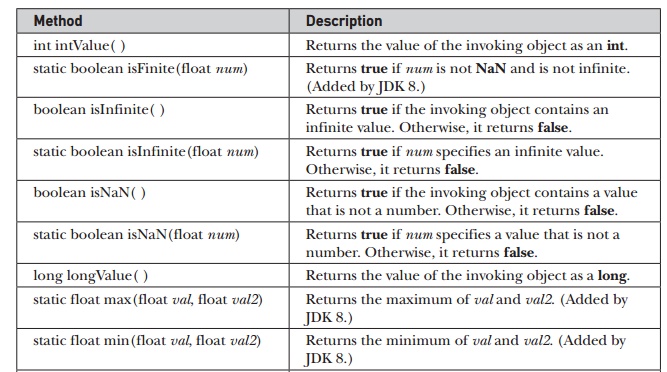
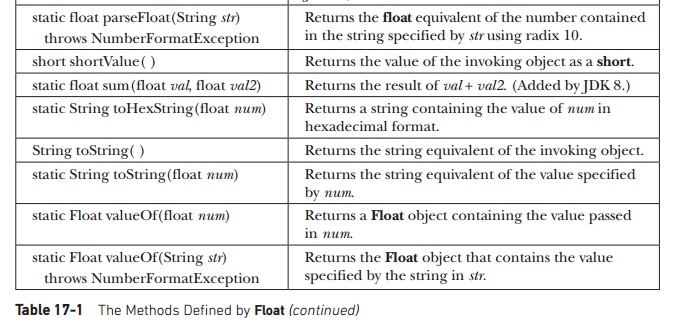
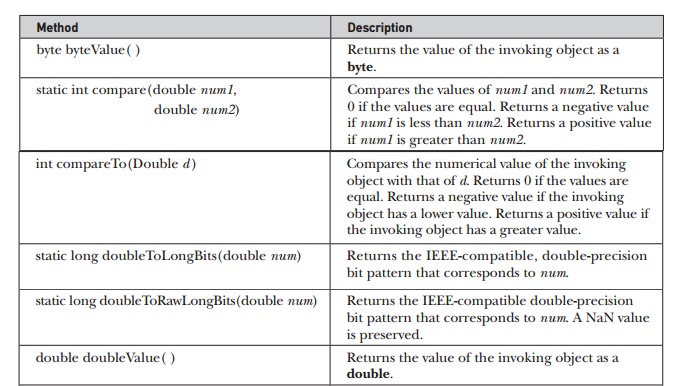
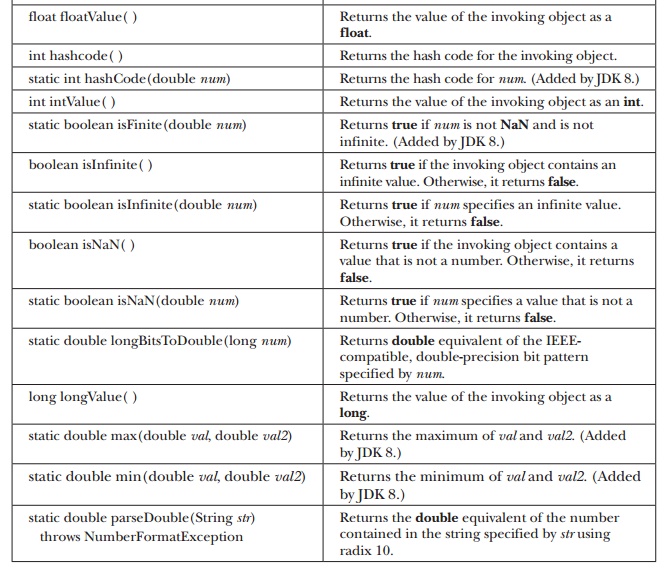
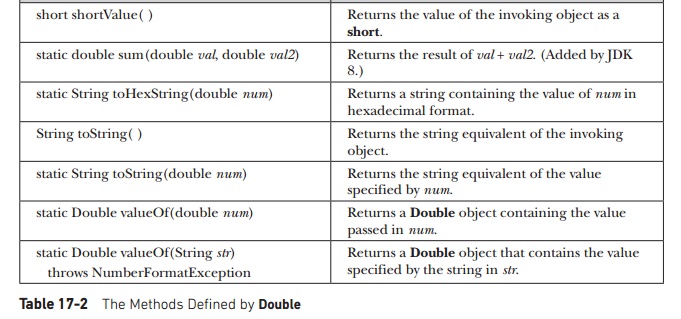
The following example creates
two Double objects—one by using a double value and the other by passing a
string that can be parsed as a double:
class DoubleDemo {
public static void main(String args[]) { Double
d1 = new Double(3.14159); Double d2 = new Double("314159E-5");
System.out.println(d1 + " = " + d2 +
" -> " + d1.equals(d2));
}
}
As you can see from the
following output, both constructors created identical Double instances, as shown by the equals( ) method returning true:
3.14159 = 3.14159 –> true
Understanding
isInfinite( ) and isNaN( )
Float and Double provide the
methods isInfinite( ) and isNaN( ), which help when manipulating two special double and float values. These methods test for two unique values defined by
the IEEE floating-point specification: infinity and NaN (not a number). isInfinite( ) returns true if the value being tested is
infinitely large or small in magnitude.
isNaN( ) returns true if the
value being tested is not a number.
The following example creates
two Double objects; one is infinite,
and the other is not a number:
// Demonstrate isInfinite() and isNaN()
class InfNaN {
public static void main(String args[]) { Double
d1 = new Double(1/0.);
Double d2 = new Double(0/0.);
System.out.println(d1 + ": " +
d1.isInfinite() + ", " + d1.isNaN()); System.out.println(d2 + ":
" + d2.isInfinite() + ", " + d2.isNaN());
}
}
This program generates the
following output:
Infinity: true, false
NaN: false, true
Byte,
Short, Integer, and Long
The Byte, Short, Integer, and Long classes are wrappers for byte,
short, int, and long integer
types, respectively. Their constructors are shown here:
Byte(byte num)
Byte(String str) throws NumberFormatException
Short(short num)
Short(String str) throws NumberFormatException
Integer(int num)
Integer(String str) throws NumberFormatException
Long(long num)
Long(String str) throws NumberFormatException
As you can see, these objects
can be constructed from numeric values or from strings that contain valid whole
number values.
The methods defined by these
classes are shown in Tables 17-3 through 17-6. As you can see, they define
methods for parsing integers from strings and converting strings back into
integers. Variants of these methods allow you to specify the radix, or numeric base, for conversion.
Common radixes are 2 for binary, 8 for octal, 10 for decimal, and 16 for
hexadecimal.
The following constants are
defined:

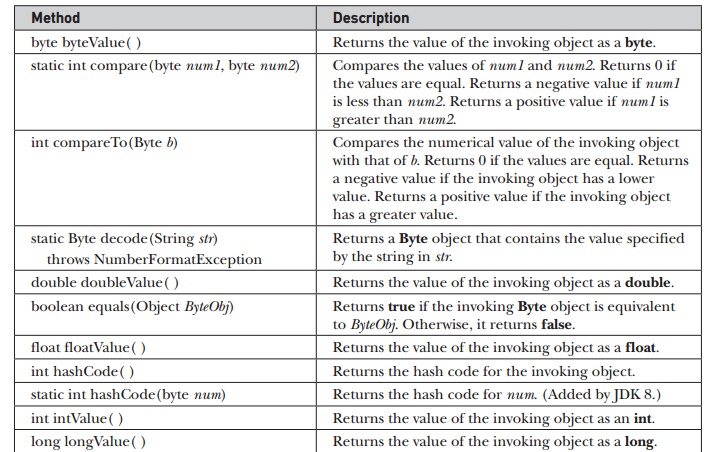
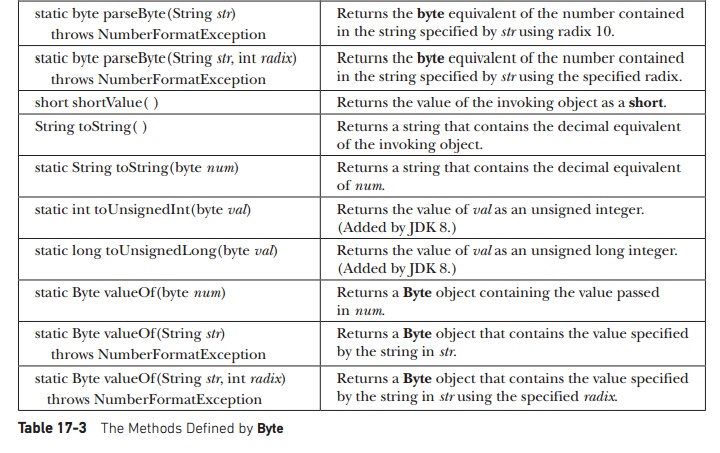

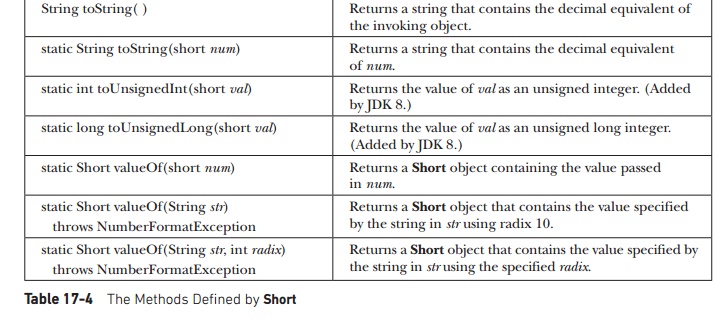
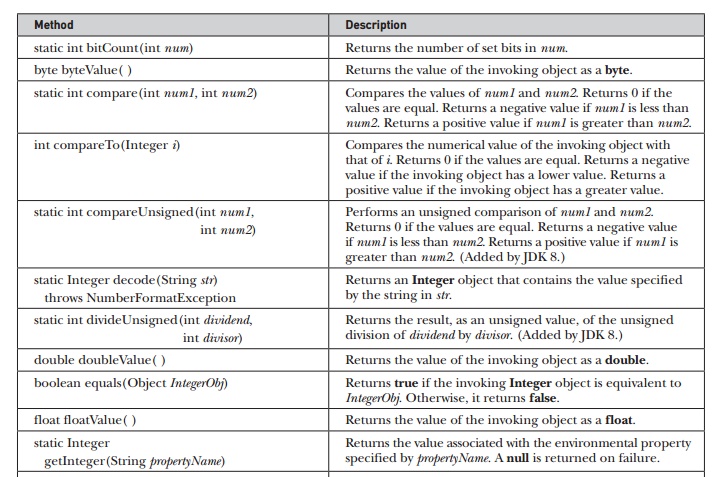
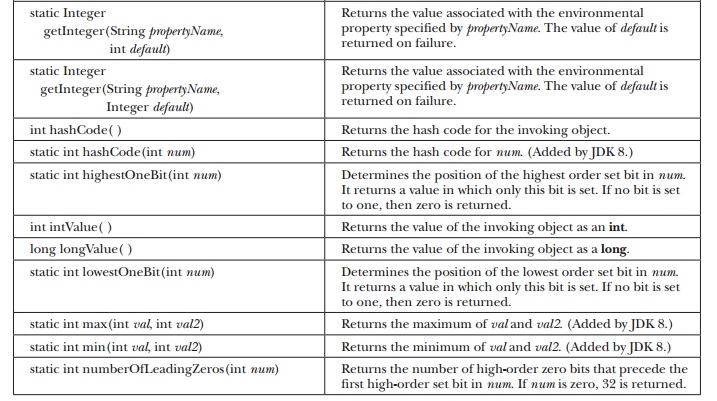
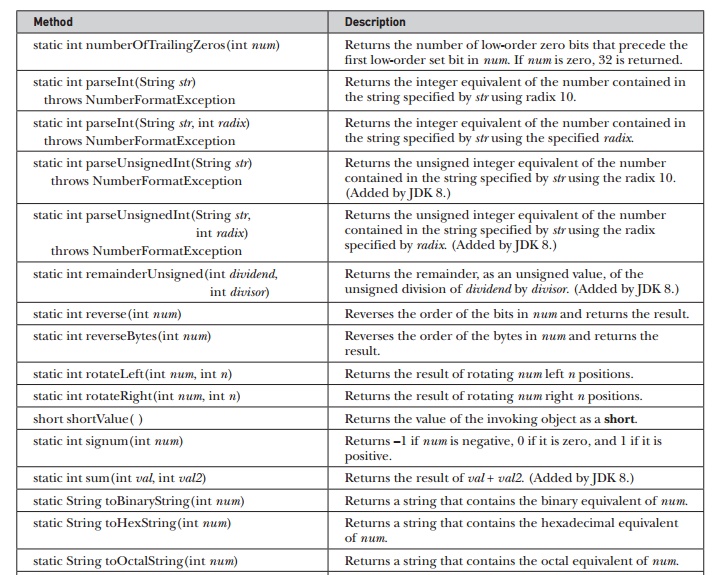
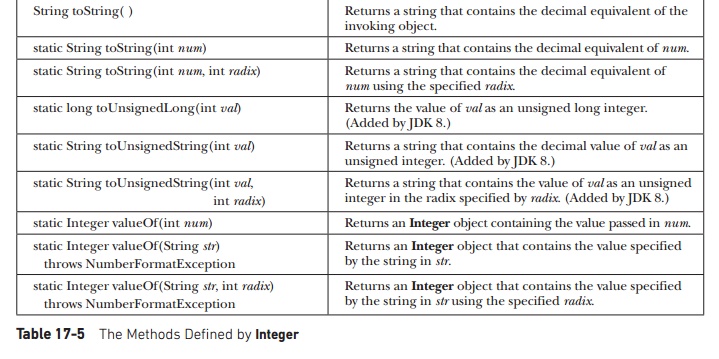
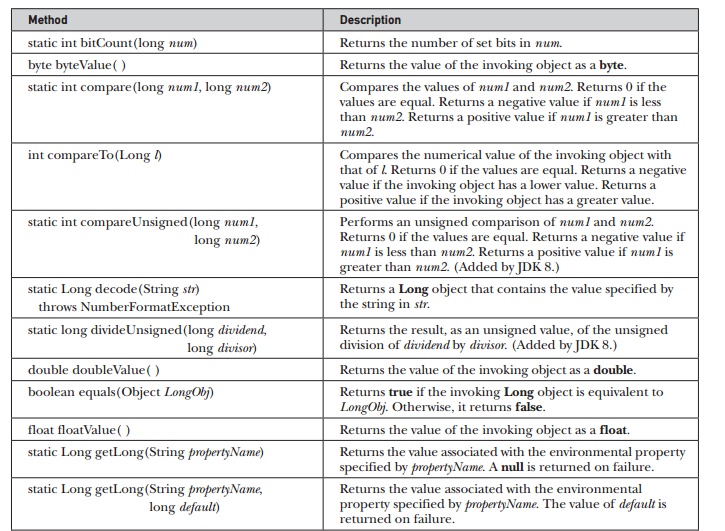
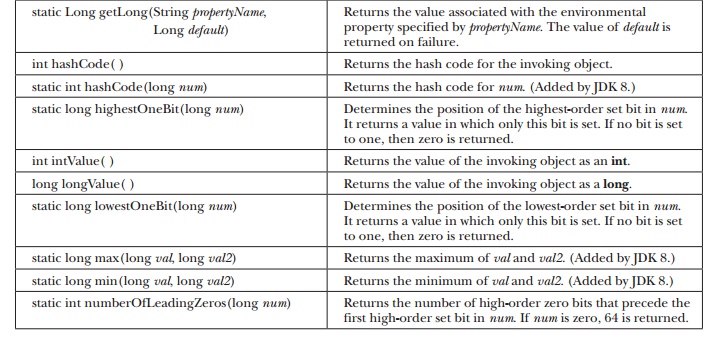
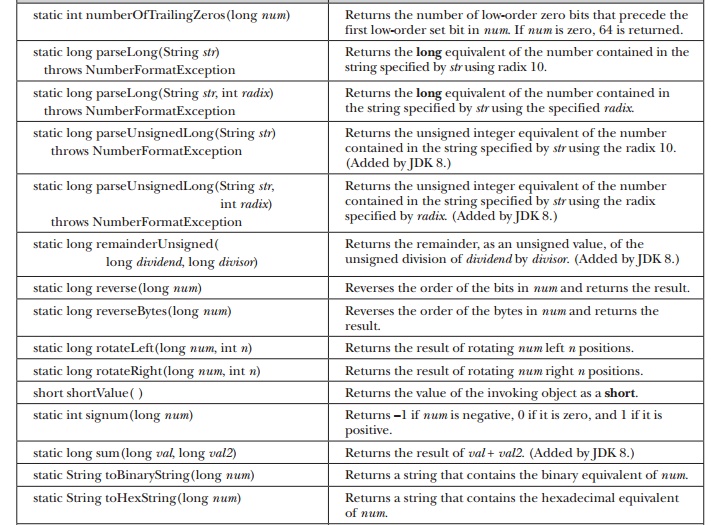
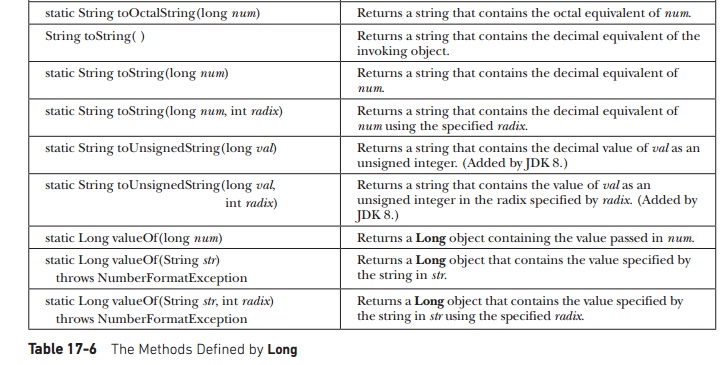
Converting
Numbers to and from Strings
One of the most common
programming chores is converting the string representation of a number into its
internal, binary format. Fortunately, Java provides an easy way to accomplish
this. The Byte, Short, Integer, and Long classes provide the parseByte( ), parseShort( ), parseInt( ),
and parseLong( ) methods,
respectively. These methods return the
byte, short, int, or long equivalent
of the numeric string with which they are called. (Similar methods also exist for the Float and Double classes.)
The following program
demonstrates parseInt( ). It sums a
list of integers entered by the user. It reads the integers using readLine( ) and uses parseInt( ) to convert these strings
into their int equivalents.
/* This program sums a list of numbers entered
by the user. It converts the string
representation of each number into an int using parseInt().
*/
import java.io.*;
class ParseDemo {
public static void main(String args[]) throws
IOException
{
// create a BufferedReader using System.in
BufferedReader br = new
BufferedReader(new
InputStreamReader(System.in)); String str;
int i; int sum=0;
System.out.println("Enter numbers, 0 to
quit."); do {
str = br.readLine(); try {
i = Integer.parseInt(str);
} catch(NumberFormatException e) {
System.out.println("Invalid format"); i = 0;
}
sum += i;
System.out.println("Current sum is: "
+ sum); } while(i != 0);
}
}
To convert a whole number
into a decimal string, use the versions of toString(
) defined in the Byte, Short, Integer, or Long
classes. The Integer and Long classes also provide the methods toBinaryString( ), toHexString( ), and toOctalString(
), which convert a value into a binary, hexadecimal, or octal string,
respectively.
The following program
demonstrates binary, hexadecimal, and octal conversion:
/* Convert an integer into binary, hexadecimal,
and octal.
*/
class StringConversions {
public static void main(String args[]) { int
num = 19648;
System.out.println(num + " in binary:
" + Integer.toBinaryString(num));
System.out.println(num + " in octal:
" +
Integer.toOctalString(num));
System.out.println(num + " in hexadecimal:
" + Integer.toHexString(num));
}
}
The output of this program is
shown here:
19648 in binary: 100110011000000
19648 in octal: 46300
19648 in hexadecimal: 4cc0
Character
Character is a simple wrapper around a
char. The constructor for Character is Character(char ch)
Here, ch specifies the character that will be wrapped by the Character object being created. To
obtain the char value contained in a
Character object, call charValue( ), shown here:
char charValue( )
It returns the character.
The Character class defines several constants, including the following:

Character includes several static methods that categorize characters and
alter their case. A sampling is
shown in Table 17-7. The following example demonstrates several of these
methods:
// Demonstrate several Is... methods.
class IsDemo {
public static void main(String args[]) { char
a[] = {'a', 'b', '5', '?', 'A', ' '};
for(int i=0; i<a.length; i++) {
if(Character.isDigit(a[i]))
System.out.println(a[i] + " is a
digit."); if(Character.isLetter(a[i]))
System.out.println(a[i] + " is a
letter."); if(Character.isWhitespace(a[i]))
System.out.println(a[i] + " is
whitespace."); if(Character.isUpperCase(a[i]))
System.out.println(a[i] + " is
uppercase."); if(Character.isLowerCase(a[i]))
System.out.println(a[i] + " is
lowercase.");
}
}
}
The output from this program
is shown here:
a is a letter.
a is lowercase.
b is a letter.
b is lowercase.
5 is a digit.
A is a letter.
A is uppercase.
is whitespace.
Character defines two methods,
forDigit( ) and digit( ), that
enable you to convert between
integer values and the digits they represent. They are shown here:
static char forDigit(int num, int radix) static int digit(char digit,
int radix)
forDigit( ) returns the digit character associated with the value of num.
The radix of the conversion is
specified by radix. digit( ) returns the integer value
associated with the specified character (which is presumably a digit) according
to the specified radix. (There is a second form of digit( ) that takes a code point. See the following section for a
discussion of code points.)
Another method defined by Character is compareTo( ), which has the following form: int compareTo(Character
c)
It returns zero if the
invoking object and c have the same
value. It returns a negative value if the invoking object has a lower value.
Otherwise, it returns a positive value.
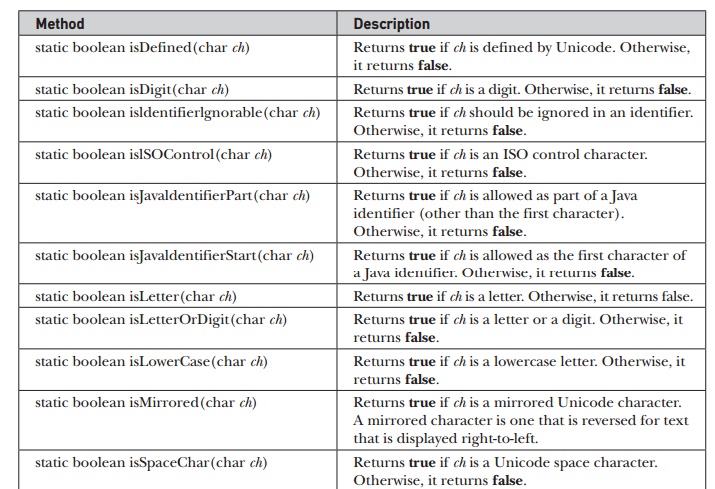
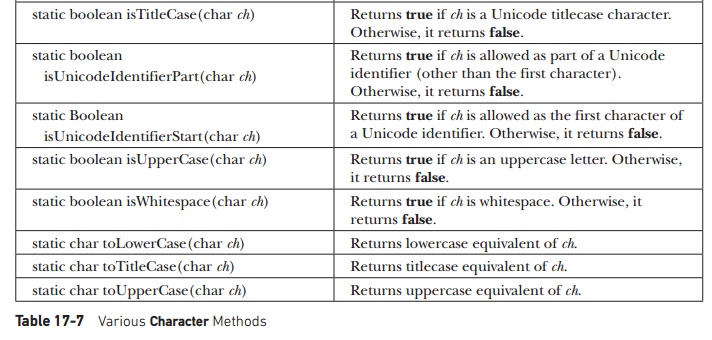
Character includes a method called
getDirectionality( ) which can be used to determine the direction of a character. Several constants are defined that
describe directionality. Most programs will not need to use character
directionality.
Character also overrides the equals( )
and hashCode( ) methods.
Two other character-related
classes are Character.Subset, used
to describe a subset of Unicode, and Character.UnicodeBlock,
which contains Unicode character blocks.
Additions
to Character for Unicode Code Point Support
Relatively recently, major
additions were made to Character.
Beginning with JDK 5, the Character class
has included support for 32-bit Unicode characters. In the past, all Unicode characters could be held by 16 bits,
which is the size of a char (and the
size of the value encapsulated within a Character),
because those values ranged from 0 to FFFF. However, the Unicode character set
has been expanded, and more than 16 bits are required. Characters can now range
from 0 to 10FFFF.
Here are three important
terms. A code point is a character in
the range 0 to 10FFFF. Characters that have values greater than FFFF are called
supplemental characters. The basic multilingual plane (BMP) are those characters between 0 and FFFF.
The expansion of the Unicode
character set caused a fundamental problem for Java. Because a supplemental
character has a value greater than a char
can hold, some means of handling the supplemental characters was needed. Java
addressed this problem in two ways. First, Java uses two chars to represent a supplemental character. The first char is called the high surrogate, and the second is called the low surrogate. New methods, such as codePointAt( ), were provided to translate between code
points and supplemental characters.
Secondly, Java overloaded
several preexisting methods in the Character
class. The overloaded forms use int
rather than char data. Because an int is large enough to hold any
character as a single value, it can be used to store any character. For
example, all of the methods in Table 17-7 have overloaded forms that operate on
int. Here is a sampling:
static boolean isDigit(int cp) static boolean isLetter(int cp) static int toLowerCase(int cp)
In addition to the methods
overloaded to accept code points, Character
adds methods that provide additional support for code points. A sampling is
shown in Table 17-8.
Boolean
Boolean is a very thin wrapper around
boolean values, which is useful mostly when you want to pass a boolean
variable by reference. It contains the constants TRUE and FALSE, which
define true and false Boolean
objects. Boolean also defines the TYPE field, which is the Class object for boolean. Boolean defines
these constructors:
Boolean(boolean boolValue)
Boolean(String boolString)
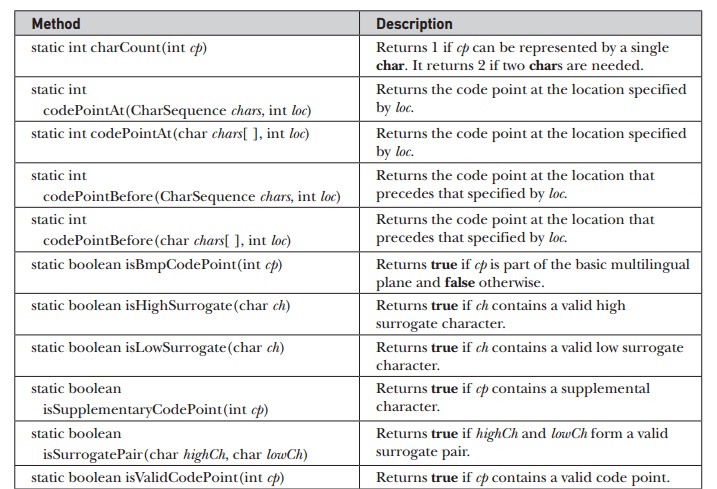

In the first version, boolValue must be either true or false. In the second version, if boolString contains the string "true" (in uppercase or
lowercase), then the new Boolean
object will be true. Otherwise, it
will be false.
Boolean defines the methods shown in Table 17-9.
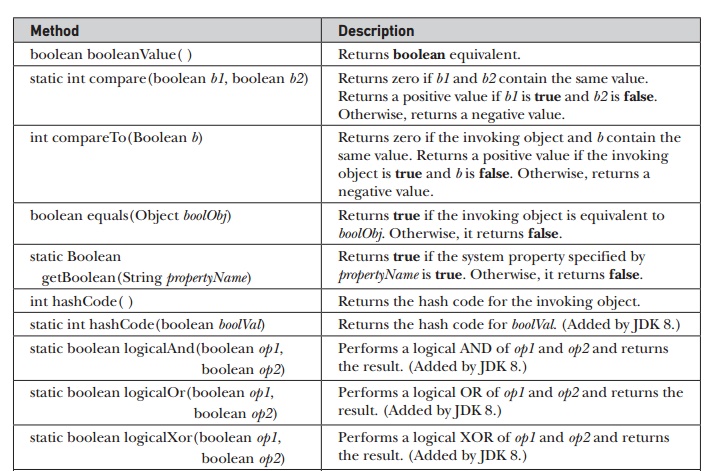

Related Topics